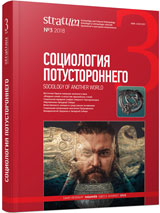Биоархеология населения лесостепного Зауралья и Западной Сибири (саргатская культура)
Bioarchaeology of the Trans-Uralian and West Siberia Forest-Steppe Population (Sargat Culture)
Author(s): Svetlana V. SharapovaSubject(s): History, Anthropology, Social Sciences, Archaeology, Cultural history, Ancient World
Published by: Издательский дом Stratum, Университет «Высшая антропологическая школа»
Keywords: Trans-Urals; Western Siberia; forest-steppe; Iron Age; Sargat culture; burial mounds; bioarchaeology; morphotype
Summary/Abstract: This article deals with materials of the Sargat culture (500 BC — 200—300 AD), which were mapped over a vast territory from the westernmost Tobol River basin to the Baraba lowland. Due to its geographical location on the northern periphery of the nomadic world the material culture of the forest-steppe population shows a very specific distinction. Based on archaeological data the scholarly consensus is that the Sargat mortuary rituals and material attributes have similar manifestation with nomads. The present study combines correlation between archaeological context and anthropological examination and opens new perspectives to a variety of social reconstructions. Despite visible similarities of the grave good assortment and funerary rites , it is now obvious that the two cultural worlds significantly differed in their life-styles, which might be reconstructed by a rigorous study of non-metrical osteological observation and paleodiet. The bioarchaeological approach enhances informative potential of skeletal remains even found in disturbed burials. Moreover, the previously suggested hypothesis on presumably active immixture of nomadic clans in rising Sargat aristocracy now obtains new evidence and real meaning based on study of ancient DNA.
Journal: Stratum plus. Археология и культурная антропология
- Issue Year: 2018
- Issue No: 3
- Page Range: 323-350
- Page Count: 28
- Language: Russian
- Content File-PDF

